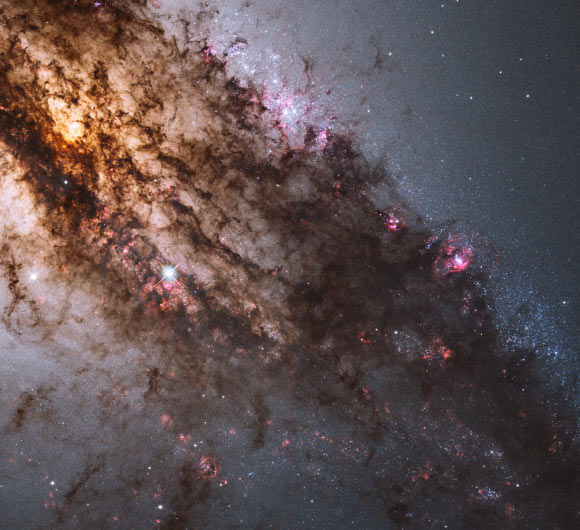A new study in the journal Science has revealed that 3 billion years after the Big Bang, elliptical galaxies still made stars on their outskirts, but no longer in their interiors.

Resembling looming rain clouds on a stormy day, dark lanes of dust crisscross the giant elliptical galaxy NGC 5128, also known as Centaurus A. The warped shape of NGC 5128’s disk of gas and dust is evidence for a past collision and merger with another galaxy. The resulting shockwaves cause hydrogen gas clouds to compress, triggering a firestorm of new star formation. At a distance of just over 11 million light-years, NGC 5128 contains the closest active galactic nucleus to Earth. The center is home for a supermassive black hole that ejects jets of high-speed gas into space, but neither the supermassive black hole or the jets are visible in this image. Image credit: NASA / ESA / Hubble Heritage / STScI / AURA / Hubble Collaboration / R. O’Connell, University of Virginia / WFC3 Scientific Oversight Committee.
The authors of the study – Dr Sandro Tacchella of ETH Zurich in Switzerland and his colleagues from Italy, Germany, Israel, and the United States – observed a total of 22 distant galaxies, spanning a range of masses, from an era about three billion years after the Big Bang.
Astronomers refer to these galaxies as red and dead as they exhibit an ample abundance of ancient red stars, but lack young blue stars and show no evidence of new star formation. The estimated ages of the red stars suggest that their host galaxies ceased to make new stars about 10 billion years ago.
Dr Tacchella and co-authors used the Wide Field Camera 3 aboard the NASA/ESA Hubble Space Telescope to obtain detailed images in the near-infrared, revealing the spatial distribution of older stars within their sample.
They also used the SINFONI instrument on ESO’s Very Large Telescope to collect light from the galaxies, showing precisely where they were churning out new stars.
According to the new data, the most massive galaxies in the sample kept up a steady production of new stars in their peripheries. In their bulging, densely packed centres, however, star formation had already stopped.
“The newly demonstrated inside-out nature of star formation shutdown in massive galaxies should shed light on the underlying mechanisms involved, which astronomers have long debated,” said co-author Dr Alvio Renzini of the Italian National Institute of Astrophysics’ Padova Observatory.
A leading hypothesis is that star-making materials are scattered by torrents of energy released by a galaxy’s central supermassive black hole as it sloppily devours matter.
Another idea is that fresh gas stops flowing into a galaxy, starving it of fuel for new stars and transforming it into a red and dead spheroid.
“There are many different theoretical suggestions for the physical mechanisms that led to the death of the massive spheroids,” said co-author Dr Natascha Förster Schreiber of the Max-Planck-Institut für extraterrestrische Physik in Garching, Germany.
“Discovering that the quenching of star formation started from the centres and marched its way outwards is a very important step towards understanding how the Universe came to look like it does now.”
_____
S. Tacchella et al. Evidence for mature bulges and an inside-out quenching phase 3 billion years after the Big Bang. Science, vol. 348, no. 6232, pp. 314-317; doi: 10.1126/science.1261094







